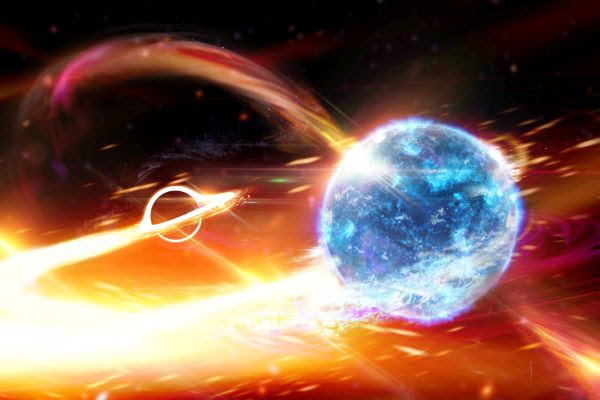Those are called neutron stars and heaviest known neutron star is two and a half times the mass of our sun while the lightest known black hole is about five solar masses. What's in that "mass gap" between neutron stars and black holes?
A new paper posits some answers.

Artistic rendering of the object in the mass gap as it combats a black hole. Credit: Carl Knox, ARC Centre of Excellence for Gravitational Wave Discovery (OzGrav) via the University of Portsmouth
Gravitational waves are emitted whenever an asymmetric object accelerates, with the strongest sources of detectable gravitational waves being from the collision of neutron stars and black holes. But a collaboration between the Laser Interferometer Gravitational-Wave Observatory (LIGO) and the Virgo detector announced the discovery of an object of 2.6 solar masses, inside the mass gap.
LIGO is gravitational-wave detectors in Louisiana and Washington while the Virgo detector is in Italy. They detected the object on August 14, 2019, as it merged with a black hole of 23 solar masses, generating a splash of gravitational waves detected by both experiments.
The mystery remains
Dozens of ground- and space-based telescopes followed up in search of light waves generated in the event, but none picked up any signals. So far, such light counterparts to gravitational-wave signals have been seen only once, in an event called GW170817. The event, discovered by the LIGO-Virgo network in August of 2017, involved a fiery collision between two neutron stars that was subsequently witnessed by dozens of telescopes on Earth and in space. Neutron star collisions are messy affairs with matter flung outward in all directions and are thus expected to shine with light. Conversely, black hole mergers, in most circumstances, are thought not to produce light.
According to the LIGO and Virgo scientists, the August 2019 event was not seen by light-based telescopes for a few possible reasons. First, this event was six times farther away than the merger observed in 2017, making it harder to pick up any light signals. Secondly, if the collision involved two black holes, it likely would have not shone with any light. Thirdly, if the object was in fact a neutron star, its 9-fold more massive black-hole partner might have swallowed it whole; a neutron star consumed whole by a black hole would not give off any light.
"I think of Pac-Man eating a little dot," said Northwestern University Professor Vicky Kalogera. "When the masses are highly asymmetric, the smaller neutron star can be eaten in one bite."





Comments